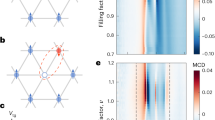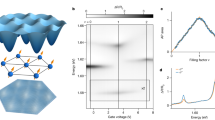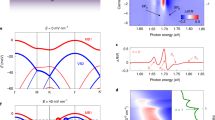Abstract
Electrons in two-dimensional semiconductor moiré materials are more delocalized around the lattice sites than those in conventional solids1,2. The non-local contributions to the magnetic interactions can therefore be as important as the Anderson superexchange3, which makes the materials a unique platform to study the effects of competing magnetic interactions3,4. Here we report evidence of strongly frustrated magnetic interactions in a Wigner–Mott insulator at a two-thirds (2/3) filling of the moiré lattice in angle-aligned WSe2/WS2 bilayers. Magneto-optical measurements show that the net exchange interaction is antiferromagnetic for filling factors below 1 with a strong suppression at a 2/3 filling. The suppression is lifted on screening of the long-range Coulomb interactions and melting of the Wigner–Mott insulators by a nearby metallic gate. The results can be qualitatively captured by a honeycomb-lattice spin model with an antiferromagnetic nearest-neighbour coupling and a ferromagnetic second-neighbour coupling. Our study establishes semiconductor moiré materials as a model system for lattice-spin physics and frustrated magnetism5.
This is a preview of subscription content, access via your institution
Access options
Access Nature and 54 other Nature Portfolio journals
Get Nature+, our best-value online-access subscription
$29.99 / 30 days
cancel any time
Subscribe to this journal
Receive 12 print issues and online access
$259.00 per year
only $21.58 per issue
Buy this article
- Purchase on Springer Link
- Instant access to full article PDF
Prices may be subject to local taxes which are calculated during checkout



Similar content being viewed by others
Data availability
All data that support the findings of this study are available from the corresponding author upon reasonable request. Source data are provided with this paper.
Code availability
All codes to analyse the reflectance spectrum are available from the corresponding author upon reasonable request.
References
Wu, F., Lovorn, T., Tutuc, E. & MacDonald, A. H. Hubbard model physics in transition metal dichalcogenide moiré bands. Phys. Rev. Lett. 121, 026402 (2018).
Wu, F., Lovorn, T., Tutuc, E., Martin, I. & MacDonald, A. H. Topological insulators in twisted transition metal dichalcogenide homobilayers. Phys. Rev. Lett. 122, 086402 (2019).
Nicolás, M. D. et al. Non-local interactions in moiré Hubbard systems. Phys. Rev. Lett. 128, 217202 (2022).
Hu, N. C. & MacDonald, A. H. Competing magnetic states in transition metal dichalcogenide moiré materials. Phys. Rev. B 104, 214403 (2021).
Balents, L. Spin liquids in frustrated magnets. Nature 464, 199–208 (2010).
Tang, Y. et al. Simulation of Hubbard model physics in WSe2/WS2 moiré superlattices. Nature 579, 353–358 (2020).
Regan, E. C. et al. Mott and generalized Wigner crystal states in WSe2/WS2 moiré superlattices. Nature 579, 359–363 (2020).
Shimazaki, Y. et al. Strongly correlated electrons and hybrid excitons in a moiré heterostructure. Nature 580, 472–477 (2020).
Wang, L. et al. Correlated electronic phases in twisted bilayer transition metal dichalcogenides. Nat. Mater. 19, 861–866 (2020).
Zhang, Y., Yuan, N. F. Q. & Fu, L. Moiré quantum chemistry: charge transfer in transition metal dichalcogenide superlattices. Phys. Rev. B 102, 201115 (2020).
Slagle, K. & Fu, L. Charge transfer excitations, pair density waves, and superconductivity in moiré materials. Phys. Rev. B 102, 235423 (2020).
Pan, H., Wu, F. & Das Sarma, S. Band topology, Hubbard model, Heisenberg model, and Dzyaloshinskii–Moriya interaction in twisted bilayer WSe2. Phys. Rev. Res. 2, 033087 (2020).
Pan, H., Wu, F. & Das Sarma, S. Quantum phase diagram of a moiré–Hubbard model. Phys. Rev. B 102, 201104 (2020).
Kennes, D. M. et al. Moiré heterostructures as a condensed-matter quantum simulator. Nat. Phys. 17, 155–163 (2021).
Huang, X. et al. Correlated insulating states at fractional fillings of the WS2/WSe2 moiré lattice. Nat. Phys. 17, 715–719 (2021).
Jin, C. et al. Stripe phases in WSe2/WS2 moiré superlattices. Nat. Mater. 20, 940–944 (2021).
Li, T. et al. Continuous Mott transition in semiconductor moiré superlattices. Nature 597, 350–354 (2021).
Ghiotto, A. et al. Quantum criticality in twisted transition metal dichalcogenides. Nature 597, 345–349 (2021).
Zhang, Y., Liu, T. & Fu, L. Electronic structures, charge transfer, and charge order in twisted transition metal dichalcogenide bilayers. Phys. Rev. B 103, 155142 (2021).
Li, H. et al. Imaging two-dimensional generalized Wigner crystals. Nature 597, 650–654 (2021).
Margarita D., Yang Z. & Fu, L. Itinerant spin polaron and metallic ferromagnetism in semiconductor moiré superlattices. Preprint at https://arxiv.org/abs/2206.01221 (2022).
Lee, K., Sharma, P., Vafek O. & Changlani, H.J. Triangular lattice Hubbard model physics at intermediate temperatures. Preprint at https://arxiv.org/abs/2209.00664 (2022).
Morales-Durán, N., Potasz, P. & MacDonald, A.H. Magnetism and quantum melting in moiré-material Wigner crystals. Preprint at https://arxiv.org/abs/2210.15168 (2022).
Jin, C. et al. Observation of moiré excitons in WSe2/WS2 heterostructure superlattices. Nature 567, 76–80 (2019).
Huang, D., Choi, J., Shih, C.-K. & Li, X. Excitons in semiconductor moiré superlattices. Nat. Nanotechnol. 17, 227–238 (2022).
Wilson, N. P., Yao, W., Shan, J. & Xu, X. Excitons and emergent quantum phenomena in stacked 2D semiconductors. Nature 599, 383–392 (2021).
Mak, K. F., Xiao, D. & Shan, J. Light–valley interactions in 2D semiconductors. Nat. Photon. 12, 451–460 (2018).
Xu, X., Yao, W., Xiao, D. & Heinz, T. F. Spin and pseudospins in layered transition metal dichalcogenides. Nat. Phys. 10, 343–350 (2014).
Spal/ek, J. et al. Magnetic susceptibility of semimagnetic semiconductors: the high-temperature regime and the role of superexchange. Phys. Rev. B 33, 3407–3418 (1986).
Zheng, W., Singh, R. R. P., McKenzie, R. H. & Coldea, R. Temperature dependence of the magnetic susceptibility for triangular-lattice antiferromagnets with spatially anisotropic exchange constants. Phys. Rev. B 71, 134422 (2005).
Tang, Y. et al. Dielectric catastrophe at the Wigner–Mott transition in a moiré superlattice. Nat. Commun. 13, 4271 (2022).
Gu, J. et al. Dipolar excitonic insulator in a moiré lattice. Nat. Phys. 18, 395–400 (2022).
Zhang, Z. et al. Correlated interlayer exciton insulator in heterostructures of monolayer WSe2 and moiré WS2/WSe2. Nat. Phys. 18, 1214–1220 (2022).
Foo, M. L. et al. Charge ordering, commensurability, and metallicity in the phase diagram of the layered NaxCoO2. Phys. Rev. Lett. 92, 247001 (2004).
Merino, J., Powell, B. J. & McKenzie, R. H. Ferromagnetism, paramagnetism, and a Curie–Weiss metal in an electron-doped Hubbard model on a triangular lattice. Phys. Rev. B 73, 235107 (2006).
Li, T. et al. Charge-order-enhanced capacitance in semiconductor moiré superlattices. Nat. Nanotechnol. 16, 1068–1072 (2021).
Wang, X. et al. Light-induced ferromagnetism in moiré superlattices. Nature 604, 468–473 (2022).
Acknowledgements
We thank V. Elser, L. Fu, E.-A. Kim and S. Kivelson for helpful discussions. This study was supported by the National Science Foundation (NSF) under DMR-1807810 (magneto-optical measurements), the Air Force Office of Scientific Research (AFOSR) under award no. FA9550-20-1-0219 (analysis), and the Cornell Center for Materials Research with funding from the NSF MRSEC program under DMR-1719875 (sample fabrication). It made use of the Cornell NanoScale Facility, an NNCI member supported by NSF grant NNCI-2025233. This research is funded in part by the Gordon and Betty Moore Foundation. The growth of WSe2 crystals was supported by the US Department of Energy (DOE), Office of Science, Basic Energy Sciences (BES), under award no. DE-SC0019481; the growth of the h-BN crystals was supported by the Elemental Strategy Initiative of MEXT, Japan, and CREST (JPMJCR15F3), JST. C.X. acknowledges support from the NSF under DMR-1920434 and the Simons Investigator program. C.-M.J. acknowledges support from the start-up funding from Cornell University. Y.T. acknowledges support from the National Basic Research Program of China (grant nos. 2022YFA1405400 and 2022YFA1402403), the National Natural Science Foundation of China (grant no. 12274365) and the start-up funding from Zhejiang University.
Author information
Authors and Affiliations
Contributions
Y.T. performed the optical measurements and the analysis. Y.T. fabricated the devices with assistance from L.L. and Y.X. S.L. and J.H. grew the bulk TMD crystals. K.W. and T.T. grew the bulk h-BN crystals. K.S., C.-M.J. and C.X. conceived and developed the spin model. K.F.M., J.S. and Y.T. designed the scientific objectives and oversaw the project. K.F.M., J.S., Y.T., K.S., C.-M.J. and C.X. co-wrote the manuscript. All the authors discussed the results and commented on the manuscript.
Corresponding authors
Ethics declarations
Competing interests
The authors declare no competing interests.
Peer review
Peer review information
Nature Nanotechnology thanks Fengcheng Wu, Su-Fei Shi and the other, anonymous, reviewer(s) for their contribution to the peer review of this work.
Additional information
Publisher’s note Springer Nature remains neutral with regard to jurisdictional claims in published maps and institutional affiliations.
Extended data
Extended Data Fig. 1 Helicity-resolved reflectance contrast spectra at varying magnetic fields.
a–c, Results for filling factor 0.88 (a), 0.67 (b) and 0.44 (c). The black and red lines denote the left (LCP) and right circularly polarized (RCP) excitations, respectively. The spectra are vertically displaced for clarity.
Extended Data Fig. 2 Analysis of MCD spectra.
a, MCD spectrum as a function of magnetic field at ν = 2/3 and 1.7 K. The vertical dashed lines denote the three energy windows (M1, M2 and M3) for the MCD analysis. b, Magnetic-field dependent MCD integrated in window M1, M2 and M3 and normalized to 1 upon saturation at large fields. The solid lines are fits to the Brillouin function. The saturation field BS obtained from the fit (shown in the key) is insensitive to the choice of the spectral window.
Extended Data Fig. 3 Magnetic response of device 1 at varying temperatures for 𝜈 = 0.33 (a), 0.57 (b), 0.8 (c) and 0.96 (d).
The color of the symbols varying from darkest to lightest denotes the temperature from 1.7 to 29.9 K.
Extended Data Fig. 4 Magnetic response of device 1 at 1.7 K.
a, Integrated MCD as a function of magnetic field and filling factor. b, Linecuts of a at selected filling factors. The curves are displaced vertically for clarity.
Extended Data Fig. 5 The magnetic susceptibility as a function of fillings at high temperature (device 1).
The dashed straight line is just an eye guidance to the linear filling dependence.
Extended Data Fig. 6 Optical characterization of device 2 at 1.7 K.
a, Filling-dependent reflectance contrast (RC) spectrum. Enhanced RC near the fundamental moiré exciton resonance of WSe2 is observed only at integer filling factors. The absence of the RC enhancement at 𝜈 = 1/3 and 2/3 supports the absence of these Wigner-Mott insulator states. b, Linecut of a at 1.673 eV.
Extended Data Fig. 7 Magneto-optical measurements (device 2).
a, MCD spectrum as a function of magnetic field at ν = 2/3 and T = 1.7 K. The spectrum is integrated over a narrow window around the fundamental moiré exciton resonance (within the two vertical lines) to represent the sample magnetization. b, Filling dependence of the magnetic susceptibility, χ, at varying temperatures. The susceptibility is extracted from the linear slope of the magnetic-field dependence of integrated MCD at zero field. The solid lines are guides to the eye. c, Curie-Weiss analysis (solid lines) of the inverse susceptibility (symbols) as a function of temperature. The error bars are propagated from the uncertainty of χ. The CW temperatures corresponding to the best fits (solid lines) are included. Data for different filling factors are vertically displaced for clarity. The horizontal dashed lines mark where 1/χ is zero. Linear dependences are observed at temperatures smaller than the CW temperatures; no sign of magnetic ordering is observed (that is no kink in the temperature dependence). The absence of magnetic ordering at temperatures smaller than the mean-field CW temperature signifies the importance of magnetic frustrations in the system.
Extended Data Fig. 8 Results from additional devices.
a, Comparison of the filling factor dependent saturation magnetic field of a 0- and 60-degree-aligned sample at 3.5 K. b–d, Results from another 60-degree-aligned sample, including the filling factor dependence of the magnetic susceptibility at 1.7 K (b), the saturation magnetic field at 1.7 K (c), and the Curie-Weiss temperature (d). The dashed lines denote 2/3 filling, where suppression of AF interactions is observed in all samples. A weaker suppression is observed in the 0-degree-aligned sample, which could be caused by the different moiré structure. The error bars correspond to the uncertainties of the Brillouin-function fit (a and c), the linear fit to the field dependence of the MCD near zero field (b), and the CW analysis (d).
Extended Data Fig. 9 Helicity-resolved reflectance contrast spectrum as a function of doping for both electron and hole doping.
a, b, d, e Gate voltage dependent left- and right-handed reflectance contrast spectrum (LCP and RCP) for the WSe2 (a, b) and WS2 (d, e) layer. The magnetic field is at 2 T. Positive and negative fillings correspond to hole and electron doping, respectively. The dashed lines label the integer filling factors. c,f, Extracted gate voltage dependent MCD spectrum for the WSe2 (c) and WS2 (f) layer. Strong MCD response is observed only in the WSe2 exciton resonance and only for the hole doping case. The results can be understood based on the type-II band alignment in WSe2/WS2 bilayers; electron (hole) doping fills the WS2 (WSe2) conduction (valence) band. Strong MCD in the WSe2 layer is expected for hole doping because states near the Fermi level are directly involved in the optical transitions. On the other hand, states near the Fermi level are not involved in the optical transitions for electron doping in W-based TMDs. The MCD response is weak in all cases for electron doping.
Extended Data Fig. 10 Determination of the saturation magnetic field (device 1).
The red curve is a Brillouin-function fit to the integrated MCD as a function of magnetic field (at 0.96 filling and 1.7 K). The corresponding saturation magnetic field is 0.63 ± 0.01 T.
Source data
Source Data Fig. 1
Filling dependence of reflectance contrast spectrum.
Source Data Fig. 2
Magnetic response of device 1.
Source Data Fig. 3
Comparison between device 1 and device 2.
Rights and permissions
Springer Nature or its licensor (e.g. a society or other partner) holds exclusive rights to this article under a publishing agreement with the author(s) or other rightsholder(s); author self-archiving of the accepted manuscript version of this article is solely governed by the terms of such publishing agreement and applicable law.
About this article
Cite this article
Tang, Y., Su, K., Li, L. et al. Evidence of frustrated magnetic interactions in a Wigner–Mott insulator. Nat. Nanotechnol. 18, 233–237 (2023). https://doi.org/10.1038/s41565-022-01309-8
Received:
Accepted:
Published:
Issue Date:
DOI: https://doi.org/10.1038/s41565-022-01309-8
This article is cited by
-
Observation of spin polarons in a frustrated moiré Hubbard system
Nature Physics (2024)
-
Interlayer exciton dynamics of transition metal dichalcogenide heterostructures under electric fields
Nano Research (2024)
-
Kinetic magnetism in triangular moiré materials
Nature (2023)
-
Tunable spin and valley excitations of correlated insulators in Γ-valley moiré bands
Nature Materials (2023)



